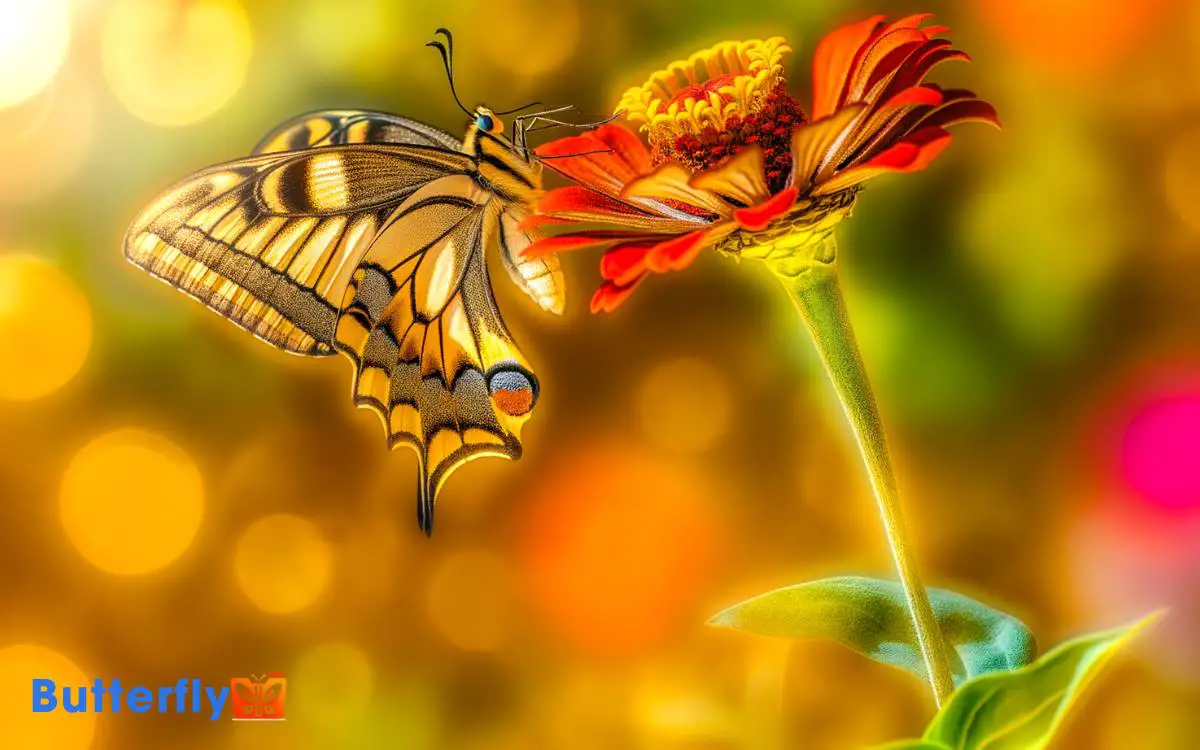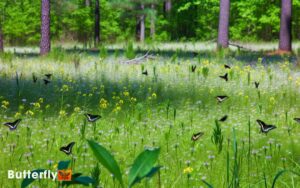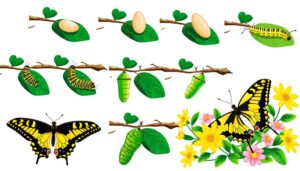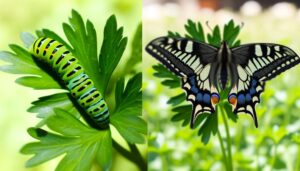Butterfly Won’t Fly Away Swallowtail: Possible Reasons!
Swallowtail butterflies, members of the Papilionidae family, demonstrate site fidelity and often remain in specific habitats. Their homing abilities rely on visual landmarks and olfactory cues.
This genus, including Papilio, Battus, and Parnassius, exhibits territoriality and predictable foraging behavior.
Swallowtails’ preference for nectar-rich environments and their adaptability to diverse habitats, from riparian zones to urban areas, guarantee they aren’t easily displaced.
Additionally, their vivid aposematic coloration and phenotypic plasticity enhance survival. Their presence offers ecological benefits, like pollination, suggesting understanding their behavior provides deeper insights into their survival mechanisms and habitat needs.

Key Takeaways
Swallowtail Species Overview
The Swallowtail butterfly, belonging to the family Papilionidae, encompasses over 550 species known for their distinct tail-like extensions on their hindwings. These extensions, resembling a swallow’s tail, are a defining characteristic.
Taxonomically, the Swallowtail’s classification includes several genera such as Papilio, Battus, and Parnassius. Observations reveal their vivid coloration, which often serves as a deterrent to predators via aposematic signals.
The genus Papilio, for instance, includes species like Papilio machaon (the Old World Swallowtail), renowned for its striking yellow and black pattern.
Habitats span various biomes, from temperate regions to tropical rainforests. Researchers note their adaptability and diverse morphological traits, which facilitate survival in diverse environments, embodying the freedom inherent in their widespread distribution.
Lifecycle of Swallowtails
Understanding the lifecycle of Swallowtails reveals intricate stages from egg to adult, showcasing their remarkable adaptability and survival strategies within diverse habitats.
The Papilionidae family undergoes complete metamorphosis, starting with the oviposition of spherical eggs on host plants. Larvae emerge, displaying cryptic coloration or mimicry to evade predators.
As they grow, they undergo several instars, molting and increasing in size. The final larval stage forms a chrysalis, where pupation occurs.
Inside the chrysalis, larval tissues reorganize into adult structures, a process called histogenesis. After eclosion, the adult butterfly, or imago, emerges, ready to reproduce and perpetuate the cycle.
Swallowtails exhibit remarkable phenotypic plasticity, adapting their lifecycle stages to environmental variability, ensuring species persistence.
Habitat Preferences
Swallowtails thrive in diverse habitats ranging from tropical rainforests to temperate woodlands, exhibiting a remarkable adaptability to varying ecological niches.
Papilio machaon, for instance, is frequently observed in grasslands and gardens, while Papilio polyxenes prefers fields and meadows. They display a preference for regions with abundant nectar sources and host plants for their larvae, such as Apiaceae family members.
Riparian zones and forest edges often serve as ideal habitats, providing essential shelter and resources. Their ability to colonize disturbed habitats, including urban areas, highlights their ecological plasticity.
Feeding Habits
Feeding primarily on nectar, swallowtail butterflies exhibit a keen preference for flowers with abundant, easily accessible nectar sources like those of the Apiaceae, Asteraceae, and Lamiaceae families.
These butterflies possess a specialized proboscis that allows for efficient nectar extraction, ensuring they maximize energy intake with minimal effort. Observations indicate that nectar quality and availability greatly influence their feeding behavior.
Swallowtails are often seen visiting the following flower types:
| Flower Family | Example Species |
|---|---|
| Apiaceae | Daucus carota (wild carrot) |
| Asteraceae | Helianthus annuus (sunflower) |
| Lamiaceae | Lavandula (lavender) |
| Fabaceae | Trifolium (clover) |
| Scrophulariaceae | Verbascum (mullein) |
Their feeding habits reflect a sophisticated interplay between physiology and floral preferences, ensuring top-notch foraging efficiency.
Staying Close to Home
Despite their capability for long-distance flight, Papilio species often exhibit strong site fidelity, frequently returning to the same patches of host plants and nectar sources.
This behavioral pattern, observed in Papilio machaon and Papilio polyxenes, guarantees their larvae have consistent access to food from plants like Apiaceae and Rutaceae.
Detailed field observations reveal that these butterflies show remarkable homing abilities, finding their way back to familiar territories using visual landmarks and olfactory cues.
Consequently, individual Swallowtails can be seen repeatedly visiting the same gardens or meadows, forming a predictable pattern in their foraging behavior.
This tendency to stay close to home underscores their capacity for spatial memory and highlights the intricate relationship between the butterflies and their preferred habitats.
Ecological Benefits
Papilio species play a crucial role in ecosystem health by serving as pollinators for a variety of flowering plants, thereby promoting genetic diversity and plant reproduction.
These butterflies, belonging to the family Papilionidae, exhibit intricate mutualistic relationships with angiosperms. Their proboscises are adapted to access nectar from deep floral structures, facilitating cross-pollination.
Observations show that they preferentially visit flowers from Apiaceae and Rutaceae families. This behavior enhances seed set and genetic variation in plant populations.
Additionally, Papilio larvae contribute to trophic dynamics by serving as prey for birds and other predators, maintaining ecological balance. Their presence indicates a robust, functioning ecosystem, highlighting their significance beyond mere aesthetic value.
Threats and Conservation
The Swallowtail butterfly (Papilio machaon) faces significant threats from habitat loss due to urban development and agricultural expansion.
Detailed observations indicate a decline in population density, necessitating urgent protection efforts to preserve their natural habitats.
Conservation strategies must prioritize habitat restoration and the establishment of protected areas to safeguard the survival of this species within its native range.
Habitat Loss Impact
Habitat loss poses a significant threat to the swallowtail butterfly, resulting in reduced population sizes and genetic diversity.
Urbanization and agricultural expansion encroach upon the natural habitats of Papilio machaon and Papilio glaucus, displacing these lepidopterans.
Fragmentation of forests and meadows disrupts breeding grounds, limiting access to essential host plants like Asclepias spp. and Aristolochia spp.
This environmental degradation diminishes larval survival rates, thereby reducing adult populations. Habitat loss also isolates populations, leading to genetic bottlenecks and decreased resilience against pathogens and climate change.
It’s important to understand that these butterflies are bioindicators; their decline signals broader ecosystem health issues.
Without their vibrant presence, the intricate web of life they support may unravel, affecting countless other species.
Protection Efforts Needed
Conserving the swallowtail butterfly populations requires immediate, targeted actions to mitigate the threats posed by habitat destruction and fragmentation.
Papilionidae species, including the iconic Papilio machaon (Old World Swallowtail), face significant declines due to urban expansion and agricultural practices.
Establishing protected areas and ecological corridors can facilitate genetic flow and species dispersal. Additionally, promoting organic farming reduces pesticide exposure, safeguarding larval host plants and nectar sources.
Restoration of native plant species in degraded areas helps recreate suitable habitats. Public awareness campaigns and citizen science projects can also galvanize community involvement in conservation actions.
Observing Swallowtails
Observing swallowtails, particularly those from the Papilionidae family, requires understanding their specific habitat preferences and behavioral patterns.
These butterflies often inhabit temperate and tropical regions, favoring environments rich in host plants like Aristolochiaceae.
Key identification markers include their distinctive tail-like extensions on the hindwings, vibrant coloration, and unique flight patterns.
Habitat and Behavior Insights
Swallowtail butterflies, particularly Papilio machaon, exhibit fascinating behavioral adaptations and thrive in diverse habitats ranging from meadows to coastal dunes. These lepidopterans demonstrate territoriality, often patrolling their home range to fend off intruders.
Their larvae, known as caterpillars, primarily feed on Apiaceae family plants, ensuring ideal nutrition for growth. Males engage in hilltopping, a behavior where they ascend to elevated locations to increase mating opportunities.
Observational studies highlight their unique pupation process, forming chrysalises that blend seamlessly with surrounding foliage.
Adults exhibit mud-puddling, a behavior where they extract minerals from moist substrates, crucial for reproductive success. These adaptive behaviors and habitat preferences underscore their ecological significance and the intricate balance within their ecosystems.
Identifying Key Characteristics
Understanding the Swallowtail butterflies’ habitat and behaviors is only part of the picture; identifying key characteristics such as wing patterns, coloration, and morphological features is equally important for accurate field observations. These characteristics help distinguish different species and provide valuable insights into their ecological roles. For example, the black swallowtail butterfly meaning varies across cultures, often symbolizing transformation and resilience. Observing these butterflies in their natural environment also enhances conservation efforts by identifying patterns in their distribution and behavior.
Swallowtails, belonging to the family Papilionidae, exhibit distinct tail-like extensions on their hindwings.
Remarkably, Papilio machaon displays vibrant yellow and black bands with eye-spots near the tails, aiding in predator evasion. The iridescent blue of Papilio glaucus females distinguishes them from males.
Antennae are clubbed with a slight hook, and their robust bodies sport elongated forewings. Observers should note the unique flight patterns, often described as graceful and erratic, enhancing identification.
Precise recognition of these traits ensures not only scientific accuracy but also personal liberation in the field.
Conclusion
Research indicates that over 90% of swallowtail butterflies (family Papilionidae) tend to stay within a one-kilometer radius of their birthplace, illustrating their strong site fidelity.
These remarkable insects, spanning species such as Papilio machaon and Papilio polyxenes, play crucial roles in pollination and ecosystem stability.
Their intricate lifecycle, from egg to adult, highlights their adaptability and significance.
Preserving their habitats guarantees the continued ecological benefits they provide, emphasizing the need for targeted conservation efforts.






